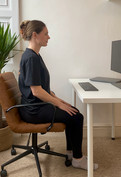What is "good" posture? Well in reality, your best posture is always your next posture. Humans are made to move, we are not made to be stuck in one position for long periods of time. Having a stiff upright posture can feel just as bad as being slumped over a computer desk if held for too long.
So why do we all think that a slumped posture is "bad" posture? Well, it's because most of us spend way too much time in that position. We work for 8 hours at a computer, drive home slumped over our steering wheels, then sit on a sofa peering down at our phones. It's not that it is a bad position, we just spend too much time in it. And what happens if we spend too much time in one position? You guessed it.... pain.
Then the solution is intuitive ... to prevent postural pain try your best to incorporate more movement into your weekly routine. This can include a balanced functional strengthening routine, mobility exercises, or even stretches at your desk. Just by moving your body more frequently you should notice your neck, back, and shoulder pain start to alleviate. Movement is key to fixing postural pain!
We have gone ahead and selected exercises that are easy to incorporate at your desk, at home or at the office. We have divided them into two categories; upper body exercises and lower body exercises.
Upper Body Postural Exercises:
1. Seated Cat Cows
This exercises is great for moving your full spine through flexion and extension. It is also simple to do at a desk. You can start with the following prescription:
3 Sets x 10 Reps, 1-2 x during your work day
2. Neck Stretch
This exercise focuses on elongating and stretching the muscles in your neck, specifically your scalene muscles.
You scalene muscles can become exceptionally tight from a slumped forward posture, and stressful breathing. Follow the prescription below to get started:
3 sets, x 10-20 second holds on each side, 1-2x during your work day
3. Scapular Squeezes
This exercise targets your rhomboid muscles and thoracic spine. It moves your spine into extension and helps strengthen the muscles between your shoulder blades.
Follow the below prescription:
3 sets, x 10 repetitions, x 3-5 second holds, 1-2 x during your work day
Lower Body Postural Exercises
1. Hip Hinges
This exercise helps move your hips through full range flexion and extension. It also strengthens your glutes and takes your thoracic spine into extension. It is a great exercise for people who sit most of the day.
Follow the below prescription:
3 sets, x10 reps, 1-2 x during your work day
2. Figure 4 Stretch
This stretch targets your glute and piriformis muscle that can become tight if seated for long periods of time. It is a simple exercise to incorporate to your desk.
Follow the prescription below:
3 sets, x 10-20 second holds, 1-2 x during your work day
3. Lateral Lunge
Out of all the lower body exercises this one may feel the best. It is a great hip opening exercise by taking your hips through a big range of motion. Lateral lunges focus on hip abduction, which is not a frequent position if you are seated in a desk for the majority of your day.
Follow the prescription below to get started:
3 sets, x 10 reps, 1-2 x during your work day
If you'd like to learn more about desk mobility exercises or how to incorporate more movement into your daily routine, book an appointment with any of our knowledgeable physiotherapists today! You can call our clinic at 604-553-1203 or book online by clicking here.
.png)
























Comments